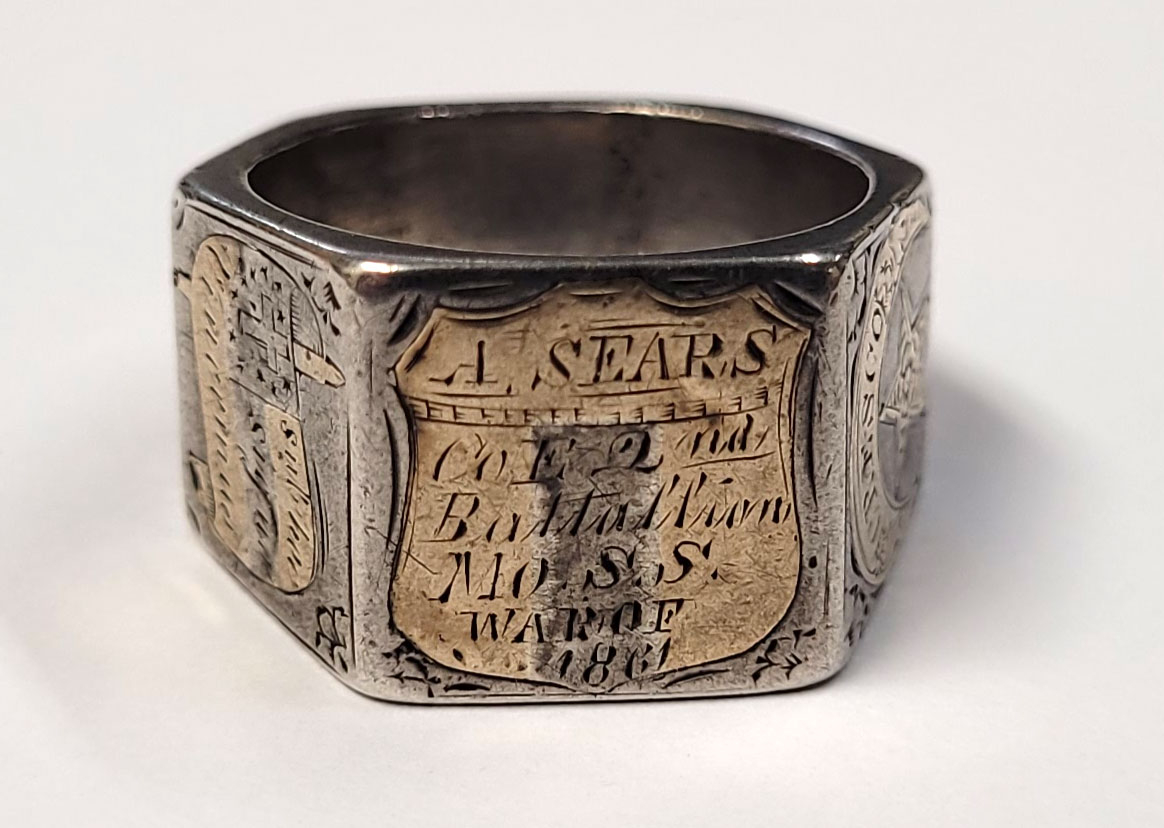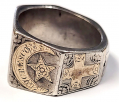site search
online catalog
CONFEDERATE SILVER AND GOLD INLAID IDENTIFICATION RING WITH PATRIOTIC AND RELIGIOUS MOTIFS AND CONFEDERATE FLAG, OF AUGUSTUS SEARS CO. E 2nd BATTALION MISSOURI SHARPSHOOTERS

$3,500.00 SOLD
Quantity Available: None
Item Code: 766-2027
This impressive silver identification ring was worn and most likely also made by Augustus Sears of Howard County, Missouri, who was a silversmith by trade and during Price’s Missouri raid served in Searcy’s Missouri Cavalry and then in Searcy’s 2nd Battalion of Missouri Sharpshooters, surrendering with them only on May 26, 1865, at New Orleans, as part of Kirby Smith’s surrender to Canby. Panels on the ring incorporate several Confederate patriotic motifs mixed with religious elements, including a Confederate shield and a Confederate First National flag using in the canton a Latin cross with clearly religious associations and a slight modification of the Constantinian “In Hoc Signo Vinces” as “Sub hoc signo Vincemus” – “Under this Sign we will Conquer,” along with a Latin cross on its own in another panel.
The ring is in very good condition, made of silver, with six sides, each with a panel inlaid with gold and engraved. Just one inlay is missing on a lower panel, clearly a star, and one of two small shields inlaid on the bottom panel. Those remaining are in excellent condition and visually impressive. As an identification ring, it is head and shoulders above the narrow silver bands with stamped identifications commercially produced for federal soldiers and also above any of the still attractive, but often crude, carved and colored bone rings produced as camp art by soldiers in both winter camps and POW compounds, though Sears likely was inspired by those pieces.
The top panel of the ring also clearly shows he was inspired by the US soldiers’ pin-back commercial identification pins that were stamped in a shield shape with the words “WAR OF 1861” at the bottom with soldier’s name and unit engraved with flourishes above. In this case he inlaid gold to form the top portion of a shield with vertical stripes below that on either side of a central vertical silver bar he left in place to form a flag of three vertical stripes: gold-silver-gold, imitating the shield form of Confederate First National flag. He then engraved his name across the top, forming the canton of the shield: A. SEARS, above a narrow, horizontal band, and below that in four lines: Co E 2nd / Battalion / MO. S.S./ WAR OF/ 1861, adding flourishes inside the shield and along its border. (We note that “battalion” is misspelled on the ring.)
Reading this top face from above, the panel next to it on the left (the upper left of the six faces,) uses the same technique of inlaid gold and engraving to create a billowing Confederate flag using three horizontal stripes of gold-silver-gold, with a silver canton containing a Latin cross surrounded by twelve stars. (Gold was also used to inlay the top of the flagstaff and the part of the staff visible beneath the lower edge of the flag.) The three stripes were then engraved, “Sub hoc / signo / Vincemus” - “Under this sign we will conquer,” a patriotic variation on the religious vision of a cross (or the “chi-rho” symbol by the Emperor Constantine with the motto “in hoc signo vinces,” “in this sign you will conquer.” The religious associations and implications of regard for the flag as a sacred emblem are inescapable.
The Confederate flag with Latin cross is now often called the “Missouri Battle Flag,” which seems appropriate for this ring, from its appearance as a simple red cross on a blue ground with red border on flags made by ladies in occupied New Orleans and smuggled to Missouri troops serving under Sterling Price in the Vicksburg campaign, where at least one was captured. The connection with Missouri, and with a sharpshooter battalion, is strengthened by the existence of another such flag in the state collections carried by the 9th Battalion of Missouri Sharpshooters. That having been said, those flags omit any stars where similar flags carried in the Kentucky Orphan Brigade include them, though in the arms of the cross. In our opinion, however, the clearest and most direct parallel is the headquarters flag of Gen. Dabney H. Maury as commander of the Department of the Gulf, made by the ladies of Mobile, AL, and flown during the siege of Mobile in March-April 1865, which, albeit using a completely red field with white border, shows a Latin cross surrounded by twelve stars, as here. (As a last note on the subject, a CS First National with provenance from an officer in the Searcy’s 2nd Battalion MO. S.S. recently came to light, which has no cross in the canton and, remarkably, uses fourteen stars.)
The panel below the flag shows a border line and corner flourishes in the silver, but the central panel, scored for a five-pointed star gold inlay, is empty. Similarly the bottom panel was cut and scored for inlay of two shields, set point next to point, with the upper edge cut in two shallow crescents. The inlay closest to the missing star is also missing, scored for the inlay but rather crudely cut along the edges, but the other shield is present, though with the top central point missing. Neither the shield nor the silver is engraved, so perhaps this bottom panel was uncompleted.
The panels adjacent to the right of the top panel are in place and like the others are gold inlaid and engraved. The upper panel bears a crescent moon, points down, encompassing a five-pointed star. The silver has floral flourishes at top and simple lines below. Both the star and the crescent moon are engraved with simple lines and floral elements: the star having a flower with petals at the center and the crescent with simple lines and short floral motif at either tip, framing a central motto: “CRESCO” – “I increase” or “I grow.” The motif has religious, masonic and fraternal associations, and like the Latin cross on the other panel also shows up on some Confederate flags- with a few South Carolina flags with a single star bracketed by other stars arranged in a crescent, or a crescent moon on a field with other stars. Its association with the western theatre of the war in particular is apparent in its selection for the badge of the Union 7th Army Corps in the Department of Arkansas. The motto “Cresco” could apply generally to prosperity through industry or religious faith, be here also nicely reflects Confederate aspirations to grow and triumph as the motto on the flag panel indicates, with the religious element brought forward once again in the panel just below it, with a simple Latin cross inlaid in gold, with no inscription, but with very well executed floral motifs engraved int the corners of the silver panel with a narrow incised border, and in the corners of the cross, also with narrow, incised border lines.
Augustus Sears was born in Howard County Missouri May 12, 1832. Details of his life are sparse. We do not find him in regular census records, though that may be a fluke or through misspelling- a county history simply calls him “Gus Sears” in its list of Confederate soldiers and we find him as “Guss” as well. We do know he had ten brothers and sisters, and that after his mother died in 1841, his father remarried in 1842, adding four half-brothers and one half-sister to the family. A key detail, however, particularly in regard to this ring, is that the July 1863 U.S. census of males of draft age, lists him as single, age 30, residing in Richmond township, Howard County, Missouri, and a silversmith by profession. At his death in 1884, also in Howard County, he was recorded as a jeweler.
The 1863 draft registration entry, like several others on the page has red line drawn though it with the remark, “Feb. 21, 1865 In Rebel Army” likely the date of a draft and when the recorder updated the record, not a date of enlistment in the Confederate army. (A younger brother living with him and working as a printer was noted a week later as having been drafted but failing to report.) He must not have joined earlier than the July 1863 registration, but his presence in the Confederate army by Fall 1864 is confirmed by his inclusion in the list of Missouri troops taking part in Sterling Price’s 1864 raid into Missouri, August 29 to December 2, 1864. There he is listed as a member of Co. E, Searcy’s Missouri Cavalry, which seems to have served in Tyler’s Brigade of Marmaduke’s Division. One of the engagements of that campaign was fought at Glasgow in Howard County, the site of two silversmith shops listed in the county history, and possibly Sears’s workplace or place of training. It may also be possible Sears joined Searcy’s cavalry regiment at that time, though a county history notes that local residents with southern sympathies, who were in the majority, tended simply to drift south to join Price’s forces at different times.
At some point after Price’s raid, Searcy’s regiment was dismounted and redesignated the 2nd Battalion Missouri Sharpshooters, less perhaps because of their marksmanship than a shortage of men or horses and the formality of assigning a battalion of sharpshooters to each brigade of infantry. A compilation of forces of the Trans-Mississippi places Searcy’s Battalion in Mitchells’ 1st Missouri Infantry Brigade of Parson’s 1st Infantry Division. The sole card in Sears’s compiled military service records indicates only that he was a private in Co. E, commanded by Capt. William H. Todd, was from Howard County and was surrendered at New Orleans as part of the forces of Kirby Smith to E.R.S. Canby on May 26, 1865, and paroled at Alexandria on June 7. Given those dates, the change of unit designation, and the similarity of the flag on the ring to Maury’s headquarters flag, we would date the ring to late 1864 or early 1865. We are told that an account by the regiment’s Major, James Kennedy, providing more precise history and service details of the unit exists in the Missouri State Historical Society, but we have not been able to access it.
Sears seems to have returned to Howard County after the war and resumed his work as silversmith and jeweler. The state’s 1876 census picks him up in the town of Fayette, apparently single, and he was interred there after his death on Feb. 18, 1884. A probate record indicates he had no will, but supplies the one detail that his middle initial was “S.”
This is an impressive ring creating no doubt about its wearer’s identity or his wartime sympathies.[sr][ph:L]
~~~~~~~~~~~~~~~~~~~~~~~~~~~~~~~~~~~
THIS ITEM, AS WITH ALL OTHER ITEMS AVAILABLE ON OUR WEB SITE,
MAY BE PURCHASED THROUGH OUR LAYAWAY PROGRAM.
CLICK HERE FOR OUR POLICIES AND TERMS.
THANK YOU!
Inquire About CONFEDERATE SILVER AND GOLD INLAID IDENTIFICATION RING WITH PATRIOTIC AND RELIGIOUS MOTIFS AND CONFEDERATE FLAG, OF AUGUSTUS SEARS CO. E 2nd BATTALION MISSOURI SHARPSHOOTERS
For inquiries, please email us at [email protected]
Most Popular
Historical Firearms Stolen From The National Civil War Museum In Harrisburg, Pa »
Theft From Gravesite Of Gen. John Reynolds »
Selection Of Unframed Prints By Don Troiani »
Fine Condition Brass Infantry Bugle Insignia »
British Imported, Confederate Used Bayonet »
Scarce New Model 1865 Sharps Still In Percussion Near Factory New »
featured item
FEDERAL MODEL 1860 LIGHT CAVALRY SABER FOUND ON EAST CAVALRY FIELD, GETTYSBURG – GEISELMAN COLLECTION
This Civil War artifact is Federal Model 1860 light cavalry saber that was recovered in the battle area at East Cavalry Field in Gettysburg. Once part of the Norbert Oyler Collection, this edged weapon specimen and its metal scabbard are fine… (942-14). Learn More »







